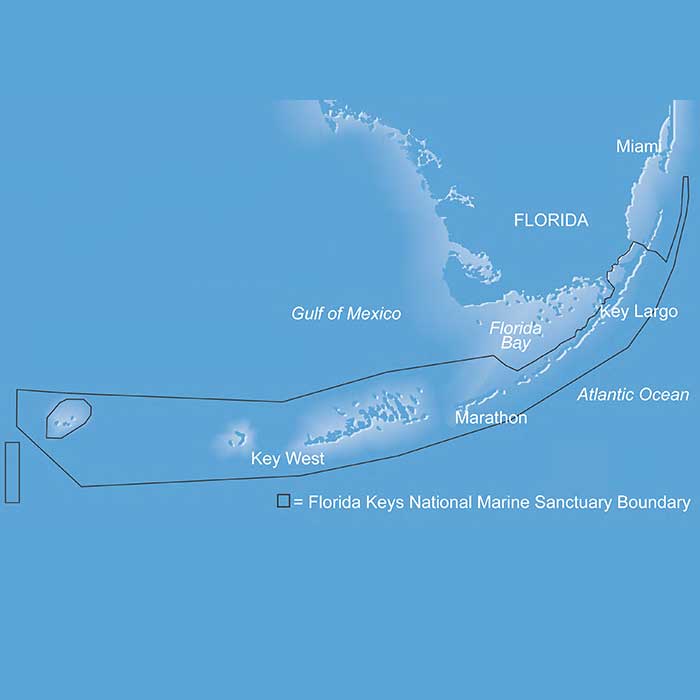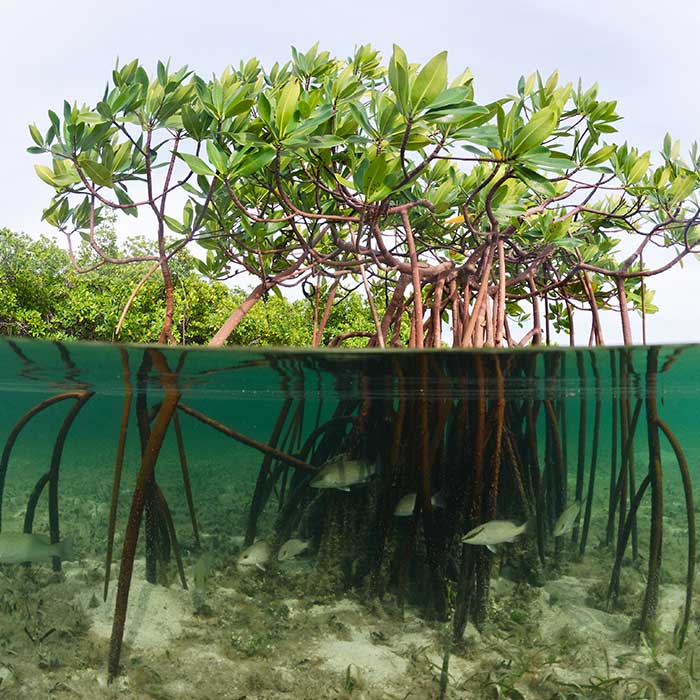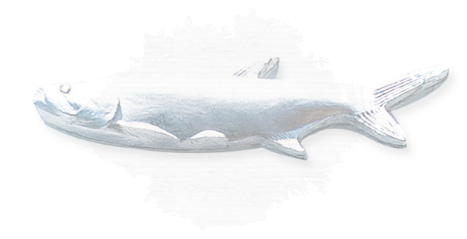The Key West Aquarium is dedicated to showcasing the wonders of the Florida Keys marine environment and our relationship with it.
The aquarium has exhibits dedicated to the different habitats, marine organisms, and industries that characterize the Florida Keys and proudly supports the efforts of multiple area conservation organizations, including Mote Marine Laboratory, Reef Relief, Plant a Million Corals Foundation, The Turtle Hospital, Save-A-Turtle, and more. We hope our guests will be inspired to help protect this special place we call home.
The Florida Keys
The Florida Keys are made up of over 1700 islands. Most are small, with only around 800 having been charted, and about 30 inhabited. These islands, and the people who live there, are intrinsically connected to the marine ecosystems that surround them. Mangroves line the shores, leading to seagrass beds that extend to coral reefs, which drop off to open ocean. Each of these habitats have a vital role to play in the larger ecosystem and efforts to conserve and restore them are ongoing.

Florida Keys National Marine Sanctuary
Key West is in the heart of the Florida Keys National Marine Sanctuary. This is an area of 2,900 nautical miles that stretches from Miami to the Dry Tortugas. The sanctuary was designated to protect the marine ecosystems surrounding the Florida Keys. These include mangrove forests, seagrass beds, coral reefs, and animals that use the habitats, like fish and sea turtles.

Sea Turtles
Florida hosts five of the seven species of sea turtles alive today: the loggerhead, green, hawksbill, Kemp’s ridley, and leatherback. All these species are threatened with extinction, ranging from classifications of threatened, to critically endangered. The Key West Aquarium is home to four non-releasable sea turtles who receive lifelong care while acting as ambassadors for their species. They represent some of the most common non-natural threats to sea turtles, including vessel strikes, marine debris entanglement, and direct harvest by humans. Two of the turtles were cared for by The Turtle Hospital in Marathon, which is a longtime partner of the Key West Aquarium. Join the Sea Turtle Conservation Tour to learn more about the sea turtles at the aquarium and what you can do to help turtles in the wild.

Mangroves
The Florida Keys are largely made up of mangrove islands. Mangroves are a group of over 50 species of salt-tolerant trees and shrubs found around the world in tropical and subtropical tidal zones. There are three species of mangrove found in the Florida Keys: the red, black, and white mangrove. The red mangrove, Rhizophora mangle, is the most common species and thrives on the water’s edge. These trees protect the islands from erosion caused by wind and water action, help reduce the impacts of storms, trap sediment that harms coral reefs, filter nutrients from the water that fuel harmful algae growth, and act as a vital habitat and nursery for many species of fish and invertebrates.

Mangroves in the Florida Keys have suffered greatly from coastal development. In fact, since the 1950’s more than 60% of the mangroves in Monroe County were destroyed by dredging, pollution from wastewater runoff and the use of herbicides. The importance of these trees was recognized in 1996 with the passage of the Mangrove Trimming and Preservation Act that made it illegal to remove, destroy, or damage mangroves in the State of Florida. Government agencies and conservation organizations are working to restore mangroves where they have been lost. A new initiative by the Plant a Million Corals Foundation and Coastlove is working to restore mangroves in the Florida Keys. Red mangroves are grown in a land-based nursery to be used in local restoration projects.

The Atlantic Shores exhibit at the Key West Aquarium is a 50,000-gallon functioning mangrove ecosystem. Red mangrove trees function in the exhibit as they would in the wild, acting as a natural filter and providing habitat for fish. The trees have been growing for almost 40 years and produce large amounts of propagules (baby trees) every year. The aquarium is looking forward to contributing to restoration efforts with this resource. Join the Atlantic Shores Game Fish and Sharks Tour for more information about mangroves and their importance to the Florida Keys.
Coral Conservation
Florida’s reef tract is the third largest barrier reef in the world and the only living barrier reef system in North America. Florida is also the only state to have extensive shallow reef formations near its coastline. The reef is home to over 6000 species, provides protection to the coast, and is the base of the economy in the Florida Keys. Unfortunately, Florida’s corals have faced unprecedented challenges in the past 4 decades and have declined by over 90%. Damage from hurricanes, pollution, vessel groundings, misplaced anchors, overfishing, disease, heat, and invasive species have all contributed to this decline.

Mission: Iconic Reefs
There are multiple restoration projects underway in the Florida Keys that use a variety of methods to address coral decline, as well as provide outreach and education for the public. The US National Oceanic and Atmospheric Administration (NOAA) has launched Mission: Iconic Reefs. This project aims to focus restoration efforts on seven iconic reefs along the Florida Reef Tract, and is one of the largest collaborative coral restoration efforts ever. Multiple government agencies as well as research institutions and non-profit organizations are working together to save the reef. These include the Florida Fish and Wildlife Conservation Commision, Florida Department of Environmental Protection, Coral Restoration Foundation, Mote Marine Laboratory and Aquarium, Florida Aquarium, The Nature Conservancy, Reef Renewal, and the National Marine Sanctuary Foundation. The Key West Aquarium supports these organizations as well as other local groups. Reef Relief is one local organization that regularly partners with the Key West Aquarium for their educational programs.
Invasive Species
Invasive species are organisms that humans have introduced into an environment that they would not otherwise be in and go on to cause ecological and economic harm. This is a major problem in Florida; the state ranks first in the nation for invasive species, with over 130 animal species classified as invasive. The Florida Keys have several invaders, including the green iguana and curly-tailed lizard on land, and red lionfish in the water. Red Lionfish are native to the Indo-Pacific and the Red Sea but are now abundant in the Caribbean and up the coast of the Atlantic, as far North as Rhode Island. This fish is a voracious predator, consuming native fish and invertebrates that are responsible for maintaining healthy coral reefs, as well as commercially important species.

The FWC sponsors annual lionfish tournaments in the state, with the goal of eradicating as many lionfish as possible while educating people about the impact of this invasive species. The Key West Aquarium took part in the first Key West Lionfish Derby in 2023 and is looking forward to continuing to support active removal of this marine invader through partnerships with community organizations. Be sure to attend the Invasive Species Tour to learn about our red lionfish and what you can do to help stop the spread!
Seagrass Conservation
The coast of Florida is surrounded by an estimated 2.7 million acres (about the area of Connecticut) of seagrass meadows. These vast underwater fields of green serve vital ecosystem functions, including nutrient cycling, food production, critical nursery habitat, coastal protection from erosion, and carbon fixation. There are seven species of seagrass in Florida, of these the most common in the Florida Keys are turtle grass, manatee grass, and shoal grass.
Seagrass is a true flowering plant, with a root system that can extend several feet into the substrate, and underground stems called rhizomes that extend horizontally. The rhizomes anchor the plants to the bottom, while the roots take up nutrients. When this structure is damaged, through accidental ship groundings or propellers hitting the bottom, scars in the seagrass bed can form. These damaged areas may continue to widen as substrate is blown away by water flowing through. It can take 10 years or more for seagrass beds to recover naturally, and the damage may remain permanent.

Seagrass beds are protected in Florida, and there are hefty fines for boaters who damage them. These reflect the value of the seagrass to the ecosystem as well as the difficulty of restoring it. There are several methods of seagrass restoration. Most involve filling in the damaged area to stabilize the bottom and then either transplanting or seeding new seagrass into it. Bird stakes are sometimes installed, encouraging wild birds to perch over the restoration area and help to naturally fertilize the plants. Restoration and monitoring projects are conducted by government agencies, such as NOAA and the Florida Department of Environmental Protection, in partnership with academic institutions and private conservation organizations, including Mote Marine Laboratory.




